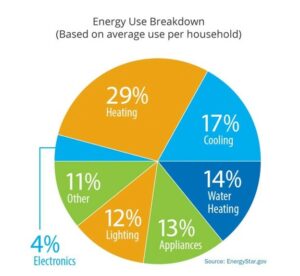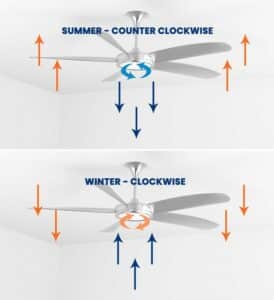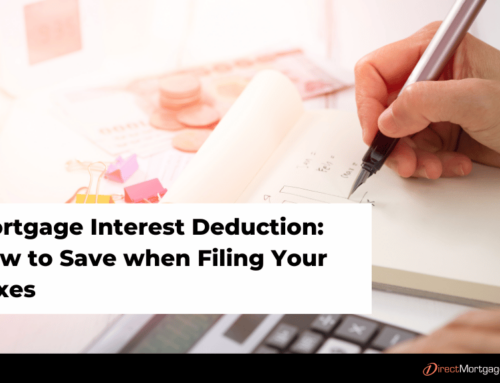Creating an energy-efficient home is a lot easier than you may think! There are several cost-effective upgrades one can make to cut down on your home’s energy usage and electricity bills. Below we have outlined everything you need to know about managing your home’s energy more effectively!
Average Household Energy Use Breakdown
Calculating your home’s energy usage is essential to identifying which appliances in your home are consuming the most energy. You can calculate your home’s energy consumption cost by multiplying the wattage, by the average number of hours in use each day. Moreover, the graph below displays a breakdown of which categories use the most energy in an average household.
Tips To Make Your Home Energy Efficient
- Use LED Light Bulbs: Replace incandescent bulbs with LED lights. This simple upgrade is a low-cost project that conserves energy and lowers your costs on your electricity bill. Moreover, LED lights have a longer life span than incandescent bulbs, so you won’t have to change them as frequently.
- Seal Your Home: Gaps and cracks in your home’s foundation can create pathways for air to escape through. Consider applying a door sweep and weather-stripping your window and door frames to prevent drafts.
- Skip the Heated Dry: Set your dishwasher drying setting to ‘low,’ or let your dishes air dry to help save on heating costs. Most newer dishwasher models come with an energy-saver dry option. Utilize that to make your home more energy efficient. Additionally, be sure to unclog the drain and food particles by cleaning it weekly to ensure it is operating efficiently.
- Unplug Electronics: Did you know electronics still use energy when plugged in even when they’re turned off? Make sure you unplug electronics like power strips and computers when not in use. You can also purchase electronic products that automatically shut off for you!
- Utilize your Windows: Investing in shades and curtains can help keep your home cozy in the winter and cool in the summer. Specifically, curtains that have an insulating liner can cut heating loss dramatically and keep the chill out in the winter months. For the summer months, opt for a sheer curtain that filters sunlight and blocks heat from the sun.
- Adjust Ceiling Fans: Adjust the controls on your ceiling fan to rotate fans clockwise, at a low speed, in the winter months to reduce heating costs. On the contrary, turn your ceiling fan counterclockwise in the summertime to keep your home cooler.
- Clean Furnace & Air Filters: Replace or clean the furnace and air filter to ensure it is working properly. It’s recommended to inspect and clean these regularly to make sure there is no dust or debris clogging the airway or entering the air.
- Use Cold Water to Wash Clothes: Although there are benefits to using hot water for removing stains and killing bacteria from your clothes, cold water uses less energy and is gentle on clothes. Use cold water to wash your clothes and save the hot water for your dirty or stained laundry.
- Skip the Bath: Take showers instead of baths to use less hot water, and try and take shorter showers. You would be surprised how cutting a couple of minutes out of your shower time each day can save you in a year.
- Manage Your Thermostat: Adjust your thermostat to 78°F in the summer and 68° F in the winter to cut back on your heating and cooling costs. If you’re not comfortable with these settings just yet, you can try adjusting the temperature gradually by 1 degree!
You don’t need to sacrifice your comfortable lifestyle or your bank account to make your home more energy efficient. Incorporating even a couple of these tips into your home can do wonders for your energy costs and the environment. If you’re looking to purchase a home, then we would be happy to help. Contact Direct Mortgage Loans today!








Leave A Comment
You must be logged in to post a comment.